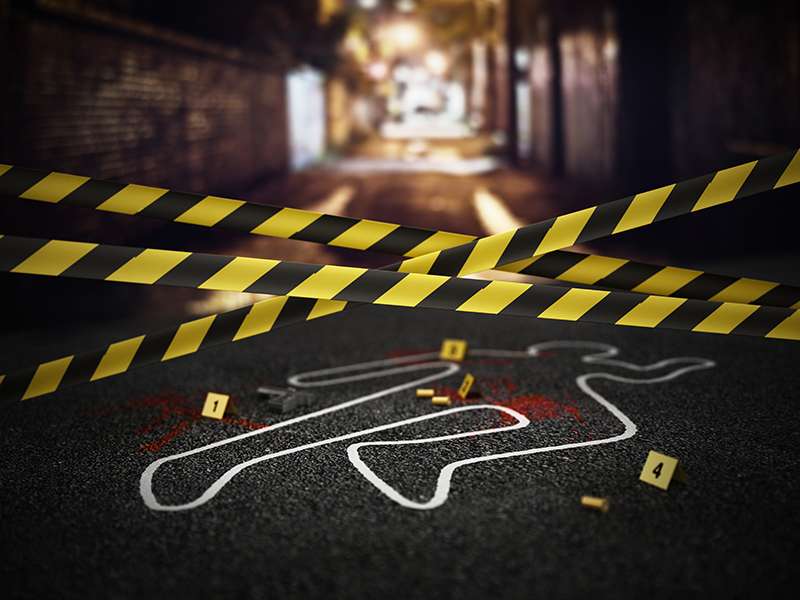
California Penal Code 187: Murder
Legal Definition: The unlawful killing of another human being with malice aforethought and without legal justification.
For a person to be convicted of a violation of PC 187, the prosecution must prove the following:
1. You committed an act that caused the death of another person/a fetus;
2. When you acted, you had a state of mind called malice aforethought;
AND
3. You killed without lawful excuse/justification.
Attempted murder is defined as taking a substantial step towards the unlawful killing of another person without legal justification and with the specific intent to kill the other person. (PC 664/187)
What does this mean?
There are two kinds of malice aforethought, express malice and implied malice. Proof of either is sufficient to establish the state of mind required for a murder charge. You acted with express malice if you unlawfully intended to kill. You acted with implied malice if:
1. You intentionally committed an act;
2. The natural and probable consequences of the act were dangerous to human life;
3. At the time you acted, you knew your act was dangerous to human life;
AND
4. You deliberately acted with conscious disregard for human/fetal life.
Malice aforethought does not require hatred or ill will toward the victim. It is a mental state that must be formed before the act that causes death is committed. It does not require deliberation or the passage of any particular period of time. A fetus is an unborn human being that has progressed beyond the embryonic stage after major structures have been outlined, which typically occurs at seven to eight weeks after fertilization.
An act causes death if death is the direct, natural, and probable consequence of the act and the death would not have happened without the act. A natural and probable consequence is one that a reasonable person would know is likely to happen if nothing unusual intervenes. In deciding whether a consequence is natural and probable, consider all of the circumstances established by the evidence. There may be more than one cause of death. An act causes death only if it is a substantial factor in causing the death. A substantial factor is more than a trivial or remote factor. However, it does not need to be the only factor that causes death.
There are four different types of mental states that make up malice aforethought: 1. Intent to kill, 2. Intent to commit great bodily injury (GBI), 3. Reckless Endangerment (Malignant Heart), 4. Inherently Dangerous Felony Murder.
The Four Intents
- Intent to kill: When you intentionally try to kill another person and succeed in doing so. This need not be some dramatic show, where you stand on a table and exclaim you are going to kill someone. Circumstantial evidence is generally used to find this, such as, if you stand over a person who is on their knees, point a gun to their head, then shoot them; the intent to kill can be shown. Generally, just using a gun creates a presumption of intent to kill because a gun is an inherently dangerous weapon. Even if you kill a person, but intended to kill another, you can still be charged with PC 187 through the concept of “transferred intent”.
- Intent to commit great bodily injury: This can be shown if you intended to severely injure another person and that the injury ended up causing the death of that other person. An example could be you intended to strangle another person with a noose, but, you were only wanting to scare them or knock them unconscious, but instead, you killed them. Your intent to commit great bodily injury through choking them will serve as malice aforethought for a murder charge. This is because a reasonable person would believe that choking a person with a noose will likely lead to death or a great bodily injury.
- Reckless Endangerment (Malignant Heart): If it can be shown that you committed such an act that is subjectively reckless, extremely dangerous, and indifferent to human life, and another person actually dies as a result of that reckless conduct, you can be found guilty of intentional murder. A common example here would be a drive-by shooting at a party. If you drive by a busy party in a vehicle and start unloading your gun into that house, then it is clear that you showed indifference to human life.
- Inherently Dangerous Felony Murder: The final way to show intent is to prove that the victim’s death occurred during the commission of an inherently dangerous felony that was committed by you. Inherently dangerous felonies are felonies that are so dangerous to human life that the likelihood of death during the commission of the crime is very likely. Some examples of these felonies include robbery, rape, kidnapping, torture, mayhem, arson, evading police, etc. For example, if a group of people is robbing a liquor store, and a hostage tries to run out of the door and gets shot, even if you were not the shooter, it can be shown that robbery is an inherently dangerous felony, and because of that, you committing the robbery makes you guilty then of Felony Murder of the hostage.
Different Degrees of Murder
1. First Degree
First-degree murder requires both premeditation and deliberation or is committed during an inherently dangerous felony. Premeditation means simply, that you thought about it, before doing it. Deliberation means you had time to consider the wrongfulness of your act and had spent time considering the idea. The formation of premeditation and deliberation of intent can happen within the span of a few seconds; such as picking up and holding a gun pointed at another person. It can also be, walking in on your significant other with another person, then leaving for a week, and returning to shoot them both dead.
2. Second Degree
This is all other murders that do not fall under First Degree murder, as simple as that. Therefore, if the killing does not occur under the elements or premeditation or deliberation described above for First Degree Murder, then by default, it is second-degree murder.
3. Watson Murder (aka second-degree murder)
A Watson murder is still considered Second Degree murder. However, this occurs when a person, who has a prior DUI conviction, gets into a car accident while driving under the influence of alcohol again, and as a result of their driving, kills another human being. More so nowadays, if you drive while under the influence of drugs or alcohol and kill another human being, with a prior DUI conviction, then the criminal charge is usually second-degree murder, as opposed to vehicular manslaughter, which is a much more serious offense.
4. Attempted Murder (PC 664/187)
This can be shown if you made a substantial step towards the act of killing another person, while simultaneously intending to kill that other person. A substantial step is something beyond mere preparation of the crime. Thoughts alone of killing another (which are thoughts we’ve all had) are not sufficient without taking a substantial step in the commission of that murder.
Involuntary manslaughter occurs when you do not intend to murder anyone but nevertheless, a person is killed as a result of your grossly negligent conduct.
Voluntary Manslaughter is a killing that happens in a heat of passion, without a sufficient cooling-off period, but with the intent to kill another person.
Penalties
- First Degree Murder: If convicted of First Degree Murder, you could face up to 25 years to life in State Prison. You would have to serve all 25 years of that, and only after, can you be eligible for Parole. First-degree murder is considered a strike in California under California’s Three Strikes Law.
- Second Degree Murder: If convicted of Second Degree Murder, you could face up to 15 years to life in State Prison. You would have to serve all 15 years of that, and only after, can you be eligible for Parole. Second-degree murder is considered a strike in California under California’s Three Strikes Law.
- Attempted Murder: If convicted of First Degree of Attempted Murder, you could face up to 25 years to life in State Prison. You would have to serve all 25 years of that, and only after, can you be eligible for Parole. If convicted of second-degree attempted murder, which is any murder attempt that isn’t willful, deliberate, and premeditated you face upwards of five, seven, or nine years in state prison.
Common Defenses
- Statute of Limitations
- Insufficient Evidence
- Self Defense
- Violation of your Rights
- Coerced Confessions
You have a right to lawfully defend yourself against an attack. You also have the right to use deadly force to repel an attacker that is using deadly force against you. This is relatively simple if a person tries to attack you, you do not have to roll over and let them kill you for fear of being charged with Murder. Self-defense has to be justified based on what you are defending against. If a person comes at you with a flip flop in hand. swinging it at your face, then it is not self-defense to pull out a bazooka and shoot them to the moon. This self-defense must be reasonable, under the circumstances.
Also, a finding that certain evidence can not be used against you because of the wrongful conduct of law enforcement in its collection of evidence, such as coerced confessions, or collecting evidence in violation of your right against unreasonable searches and seizures without probable cause, can be useful in keeping certain bits of evidence out of Court and not able to be used against you.
Call Today
Murder is the most serious of cases that exist in California’s Criminal Law. You cannot afford to allow your case to be handled by just any attorney. You need someone who can fight for you, who can hear your story, and find the holes in the Prosecutor’s case. Even if you did kill another person, it doesn’t necessarily mean that it is a murder. I’ve handled many murder cases, and been able to mitigate the damage to make sure my clients will one day have a life again, and I will do the same for you, or your loved ones. Our PC 187 Ontario attorney has successfully defended numerous cases involving Murder under PC 187. The initial consultation is free and we are available to answer your questions 24/7. Call the Inland Empire Criminal Defense today at 909-939-7126! Located in Ontario, CA.
Frequently Asked Questions
Absolutely, Inland Empire Criminal Defense prioritizes your privacy and confidentiality. Every consultation with our attorney is conducted with the utmost discretion, ensuring your information remains secure and private.
Yes, understanding the financial pressures that can come with legal representation, our attorney offers flexible payment plans. This approach ensures that quality legal defense is accessible for all our clients in Riverside, San Bernardino, and Los Angeles Counties.
Yes, Inland Empire Criminal Defense offers free consultations. This is part of our commitment to providing accessible and transparent legal services to residents of Riverside, San Bernardino, and Los Angeles Counties.
We offer both in-person and over-the-phone consultations to accommodate your preferences and needs. Whether you’re in Riverside, San Bernardino, or Los Angeles County, we ensure that you can access our legal services in the way that suits you best.
Our office is typically closed on weekends. However, we do make exceptions for meetings by special arrangement. Our commitment is to be as accommodating as possible to meet the unique needs of our clients in Riverside, San Bernardino, and Los Angeles Counties.
Our legal services are specifically tailored to residents of Riverside, San Bernardino, and Los Angeles Counties. For cases outside these areas, we recommend consulting avvo.com to find appropriate legal assistance. Our focused approach allows us to provide specialized defense catering to the unique legal landscape of these counties.












